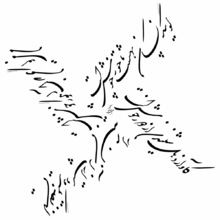Rubaʿi
Rubāʿī (Persian: رباعی, rubāʿiyy, plural: رباعيات, rubāʿiyāt)[1] is the term for a quatrain, a poem or a verse of a poem consisting of four lines. It refers specifically to a form of Persian poetry, or its derivative form in English and other languages.

In classical Persian poetry, the ruba'i is written as a four-line (or two-couplet) poem, with a rhyme-scheme AABA or AAAA.[2][3][4][5]
This is an example of a ruba'i from Rūmī's Dīwān-i Shams:
Anwār-i Ṣalāḥ-i Dīn bar angēkhta bād |
May the splendors of Salahuddin be roused, |
Metre
The usual metre of a Persian ruba'i, which is used for all four lines of the above quatrain by Rumi, is as follows:[7]
- – – u u – u – u – – u u –
In the above scheme, "–" represents a long syllable, and "u" a short one. As variations of this scheme, any sequence of – u can be replaced by a single "overlong" syllable, such as gēkh, tīf, luṭf in the poem above, containing either a long vowel followed by a consonant other than "n", or a short vowel followed by two consonants. An overlong syllable can also freely be substituted for the final syllable of the line, as with bād above.
Another variation is that occasionally a sequence of two short syllables (u u) can be replaced by a single long one (–).
A third variation is to use the same metre as above, but with the eighth and ninth syllables reversed:
- – – u u – – u u – – u u –
In English
The verse form AABA as used in English verse is known as the Rubaiyat Quatrain due to its use by Edward FitzGerald in his famous 1859 translation, Rubaiyat of Omar Khayyam. Algernon Charles Swinburne, one of the first admirers of FitzGerald's translation of Khayyam's medieval Persian verses, was the first to imitate the stanza form, which subsequently became popular and was used widely, as in the case of Robert Frost's 1922 poem "Stopping by Woods on a Snowy Evening".
FitzGerald's translation became so popular by the turn of the century that hundreds of American humorists wrote parodies using the form and, to varying degrees, the content of his stanzas, including The Rubaiyat of Ohow Dryyam, The Rubaiyat of A Persian Kitten, The Rubaiyat of Omar Cayenne and The Rubaiyat of Omar Khayyam, Jr.
Quatrain VII from the fourth edition of FitzGerald's Rubaiyat:
Come, fill the Cup, and in the fire of Spring
Your Winter-garment of Repentance fling:
The Bird of Time has but a little way
To flutter—and the Bird is on the Wing.[8]
In extended sequences of ruba'i stanzas, the convention is sometimes extended so that the unrhymed line of the current stanza becomes the rhyme for the following stanza.[9] The structure can be made cyclical by linking the unrhymed line of the final stanza back to the first stanza: ZZAZ.[10] These more stringent systems were not, however, used by FitzGerald in his Rubaiyat.
See also
- Rubaiyat of Omar Khayyam
- 'Parwaze Taffakkur' – published in 2015 containing about 250 Persian Rubaiyat of renowned Indian Poet Syed Waheed Ashraf[11]
References
- The Persian noun is borrowed from Arabic rubāʿiyy (رباعي) "consisting of four, quadripartite, fourfold" whose root consonants r-b-ʿ (ر ب ع) also occur in the numeral arbaʿah (أربعة, 'four'). See: Cowan, J. M., ed. 1994. The Hans Wehr Dictionary of Modern Written Arabic (4th edition). Wiesbaden: Harrassowitz.
- Princeton Encyclopedia of Poetry and Poetics, Princeton University Press, 1974, p.611
- Introduction to The Rubaiyat of Omar Khayyam, translated by Peter Avery and John Heath-Stubbs, Penguin Classics, 1981, ISBN 0-14-044384-3, p. 9
- The Cambridge History of Iran, v. 4, edited by R. N. Frye, Cambridge University Press, 1999, ISBN 0-521-20093-8, pgs. 633-634
- Elwell-Sutton, L. P. "The Foundations of Persian Prosody and Metrics," Iran, v. 13 (1975), p. 92.
- "The Splendors of Salahuddin".
- L. P. Elwell-Sutton (1986), “ʿARŪŻ,” Encyclopaedia Iranica, II/6-7, pp. 670-679.
- Skelton, Robin (2002). The Shapes of Our Singing: A Comprehensive Guide to Verse Forms and Metres from Around the World. Spokane, WA: Eastern Washington University Press. p. 106. ISBN 0-910055-76-9.
- Turco, Lewis (2000). The Book of Forms: A Handbook of Poetics. Lebanon, NH: University Press of New England. p. 245. ISBN 1-58465-022-2.
External links
- Dr.Amjad Parvez (25 March 2013). "A splendid poetry collection". Daily Times. Archived from the original on 18 January 2014. Retrieved 11 April 2014.
- Tajik girls reciting ruba'i quatrains